



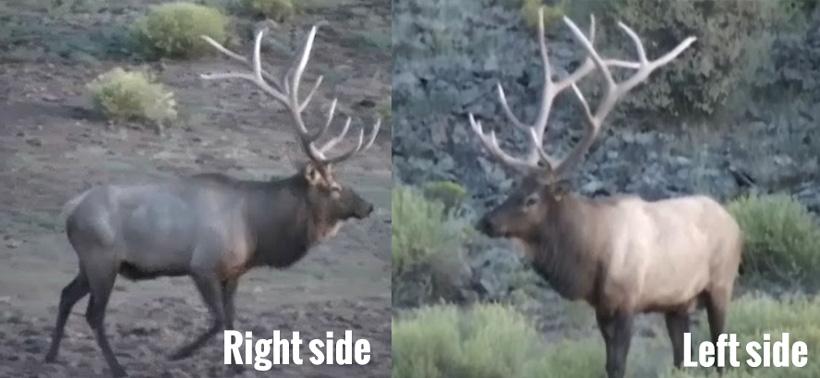
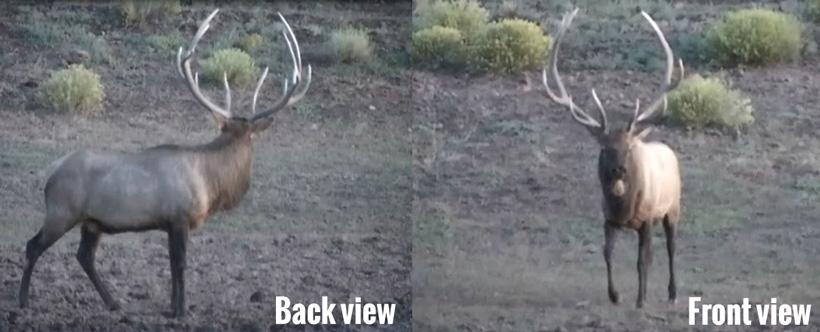
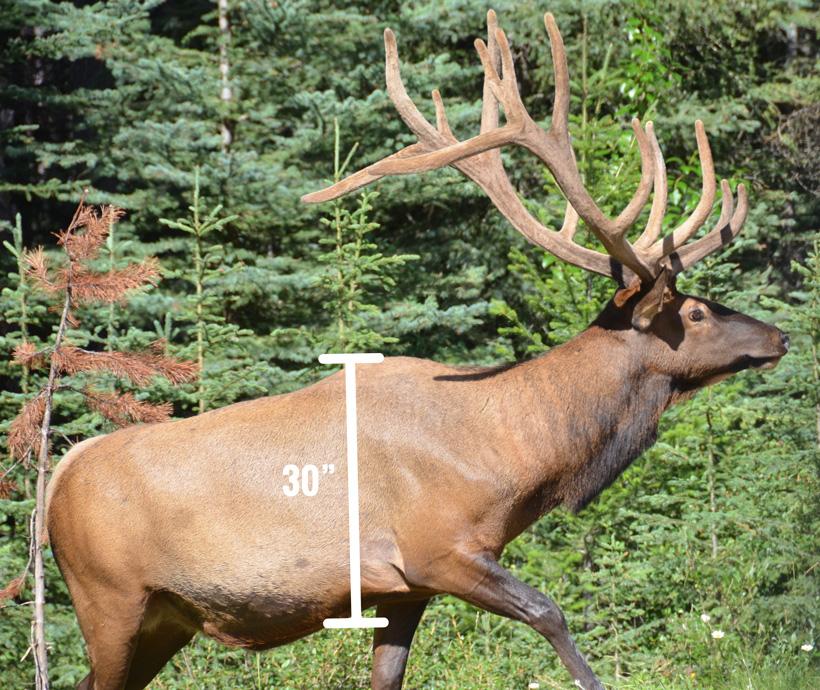
Bull elk depth of body from back to belly measurement. Photo credit: Lauren Moxley
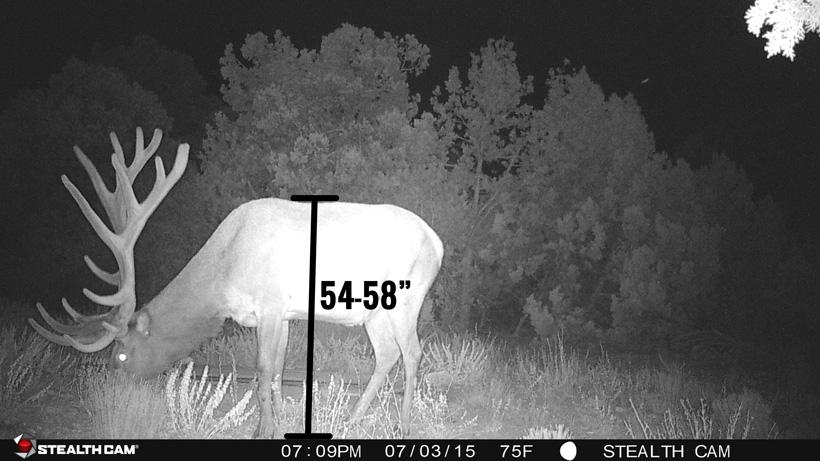
From the top of the hump on the back to the hoof is 54-58". Photo credit: Exclusive Pursuit Outfitters
Antler burr to tip of nose |
15” to 16” |
Front of eye to tip of nose |
12” to 13” |
Inside of eye to inside of eye |
7” to 8” |
Top of back to bottom of belly |
30” |
Top of back to hoof |
54-58" |
Tip of ear to tip of ear |
21” to 22” |
Ear length (base to tip) |
7.5” |
Antler burr to tip of nose | 15” to 16” |
Front of eye to tip of nose | 12” to 13” |
Inside of eye to inside of eye | 7” to 8” |
Top of back to bottom of belly | 30” |
Top of back to hoof | 54-58" |
Tip of ear to tip of ear | 21” to 22” |
Ear length (base to tip) | 7.5” |
Tine Length - 45% |
Main beam - 28% |
Mass - 16% |
Spread - 11% |
Tine Length - 45% |
Main beam - 28% |
Mass - 16% |
Spread - 11% |
| 300-310" bull |
|---|---|
Spread | 35" |
Mainbeam | 45" x 2 |
Mass | 25" x 2 |
Pointlength | 13" x 5 x 2 |
Addedup | 35+90+50+130 |
Total | 305" |
| 320-330" bull |
Spread | 37" |
Mainbeam | 47" x 2 |
Mass | 27" x 2 |
Pointlength | 14" x 5 x 2 |
Addedup | 37+94+54+140 |
Total | 325" |
| 340-350" bull |
Spread | 38" |
Mainbeam | 50" x 2 |
Mass | 29" x 2 |
Pointlength | 15" x 5 x 2 |
Addedup | 38+100+58+150 |
Total | 346" |
| 360-370" bull |
Spread | 39" |
Mainbeam | 52" x 2 |
Mass | 30" x 2 |
Pointlength | 16" x 5 x 2 |
Addedup | 39+104+60+160 |
Total | 363" |
| 380-390" bull |
Spread | 40" |
Mainbeam | 53" x 2 |
Mass | 30" x 2 |
Pointlength | 18" x 5 x 2 |
Addedup | 40+106+60+180 |
Total | 386" |
| 400"+ bull |
Spread | 40" |
Mainbeam | 53" x 2 |
Mass | 31" x 2 |
Pointlength | 20" x 5 x 2 |
Addedup | 40+106+62+200 |
Total | 408" |
| Spread | Mainbeam | Mass | Pointlength | Addedup | Total |
|---|---|---|---|---|---|---|
300-310" bull | 35" | 45" x 2 | 25" x 2 | 13" x 5 x 2 | 35+90+50+130 | 305" |
320-330" bull | 37" | 47" x 2 | 27" x 2 | 14" x 5 x 2 | 37+94+54+140 | 325" |
340-350" bull | 38" | 50" x 2 | 29" x 2 | 15" x 5 x 2 | 38+100+58+150 | 346" |
360-370" bull | 39" | 52" x 2 | 30" x 2 | 16" x 5 x 2 | 39+104+60+160 | 363" |
380-390" bull | 40" | 53" x 2 | 30" x 2 | 18" x 5 x 2 | 40+106+60+180 | 386" |
400"+ bull | 40" | 53" x 2 | 31" x 2 | 20" x 5 x 2 | 40+106+62+200 | 408" |
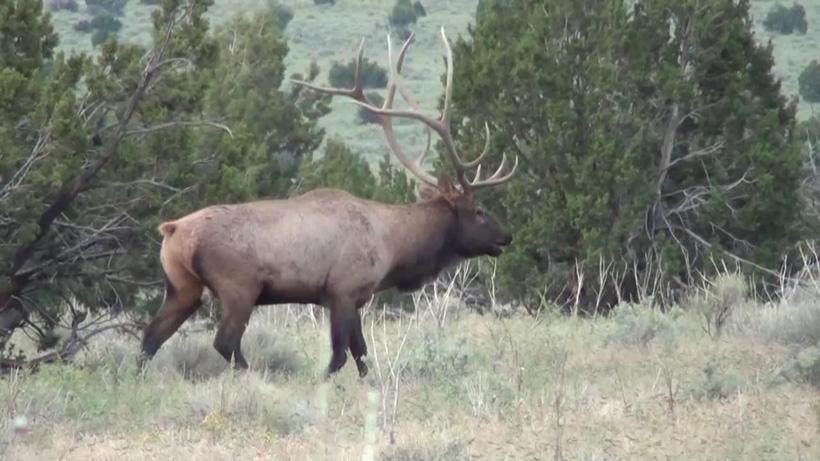
Photo credit: Exclusive Pursuits Outfitters
This is part two in the how to score and field judge elk series. If you missed part one, you can check it out here.
Last time I discussed air judging, estimate actual measurements method, magic number/estimate shortest points method and a short four part how to score an elk video series. This time around we are going to dive deeper into field juding and scoring bulls.
Here is an example with the actual measurements of the bull that was harvested by Colburn and Scott Outfitters hunter Tim Allen in 2009 in Arizona Unit 10 during the archery hunt.
Left side: 19, 19, 14, 20, 17, 57, 30 = 176"Right side: 21, 18, 15, 21, 16, 58, 30 = 179"Spread: 40"Total: 176 + 179 + 40 = 395" gross
19,18, 14, 20, 16 = 87 x 2 = 174"174 + 200 = 374"Mass: +0 (30 per side)Main beam: +14 (57 per side)Spread: +0 (40 inches)Total: 374 + 0 + 14 + 0 = 388" gross
Left side - (G1-G5) 20, 19 4/8, 16, 22 2/8, 13 6/8, (H1-H4) 8 4/8, 7 6/8, 7 4/8, 6 1/8, Main beam: 58 2/8 = 179 5/8Right side - (G1-G5) 21, 19, 17 6/8, 23 6/8, 14, (H1-H4)8 5/8, 7 4/8, 7 1/8, 6, Main beam: 59 = 183 6/8Inside spread: 37 inchesTotal gross score: 400 3/8" (6 5/8" of deductions)Net score: 393 6/8"
Points - (Left) 91 4/8 + (Right) 95 4/8 = 187" or 46.7%Main Beam - (Left) 58 2/8 + (Right) 59= 117 2/8" or 29.2%Mass - (Left) 29 7/8 + (Right) 29 2/8 = 59 1/8" or 14.75%Inside spread = 37" or 9.25%
(bull was also taken by KUIU's Jason Hairston)
Field judging elk is an art, while measuring dead elk is a science! One of the best ways to improve your field judging skills is to practice field judging bulls before actually measuring them. I hope these scoring methods and tips will come in handy when trying to field judge your trophy bull, but remember: it is more important to measure your hunt success by the memories and quality experience gained than by the size of the antlers you bring home.
Point length is the single most important ingredient for a bull to score high. Next is main beam length. It is rare to have a high scoring bull without long points and beams.
On a typical 7x7, the point measurement is going to go up dramatically. For instance, a typical 7x7 will usually have sixth points that measure from four to 20” per side, which can add an extra eight to 40” to the bull’s total gross score. Note: On a typical 7x7, you do not receive any extra mass measurements.
Look for any weaknesses or broken/missing points as they can affect the score dramatically.
Use anatomical references to judge measurements.
Count the number of points on each side because if something looks odd it usually is.
The main beam length from burr to fourth point is usually around 30”. Make sure that you compare that to the length of the main beam from the fourth point to tip of the beam. If it looks like it is about half as long (15”), then the total length is closer to 45”. If it looks equally as long, then it might be pushing 60”.
Main beams are rarely 60” or more. Inside spread measurements are rarely over 45” and mass is rarely over 32” per side.
Try to err on the short side when estimating measurements.
Look for good spacing between the points. If the points look close together, the beams are probably not as long as you think.
If a beam or point looks straight, then it will be shorter than you think. Look for lots of belly or curve in points and the main beam. Curve means greater length.